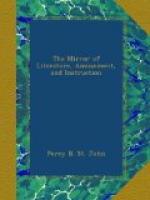FROM A CORRESPONDENT.
* * * * *
SPIRIT OF DISCOVERY.
* * * * *
STEAM CARRIAGES ON COMMON ROADS.
[One of the most accredited works upon this vital topic is An Historical and Practical Treatise upon Elemental Locomotion; by Mr. Alexander Gordon, Civil Engineer. It shows the commercial, political, and moral advantages; the means by which an elemental power is obtained; the rise, progress, and description of steam-carriages; the roads upon which they may be made to travel; and the ways and means for their general introduction. This arrangement of the subject is exceedingly well executed by Mr. Gordon, who has added a series of efficient illustrations—from a diagram simplifying the high-pressure modification of the steam-engine as applied to steam-carriages, to the last completed Steam Drag and Carriage attached; while the most material points of Mr. Gordon’s views are fortified by a condensation of the evidence before the select committee of the House of Commons. All this and much more is accomplished within two hundred octavo pages, which a less economical and therefore less praiseworthy editor would have expanded into a costly quarto. Mr. Gordon’s work has thus been planned and executed in the right spirit: he maintains national benefits which must arise from the adoption of steam carriages, and he seeks to place his views in the hands of all who are immediately interested in the subject by means as efficient as economical. We quote a few extracts, (the most interesting to the general reader,) from the first chapter, which aims at a cursory estimate of a few of the leading commercial, political, and moral advantages which will accrue to the community by the substitution of inanimate or steam power for animate or horse power, for locomotive purposes; leaving its spirit of fairness to the just appreciation of the reader.]
Economy of Conveyance.
In a great commercial country like ours, extending its ramifications to every branch of natural and artificial produce, it is almost superfluous to remark that a vast capital is sunk annually in the mere transport of marketable commodities: and which is not only a loss to the seller as being an unproductive outlay, but entails a heavy increase of expense to the buyer also upon every article of daily consumption. Any means, therefore, that will accelerate the conveyance, and at the same time reduce materially the expense of carriage, bears upon its surface a great public gain.




